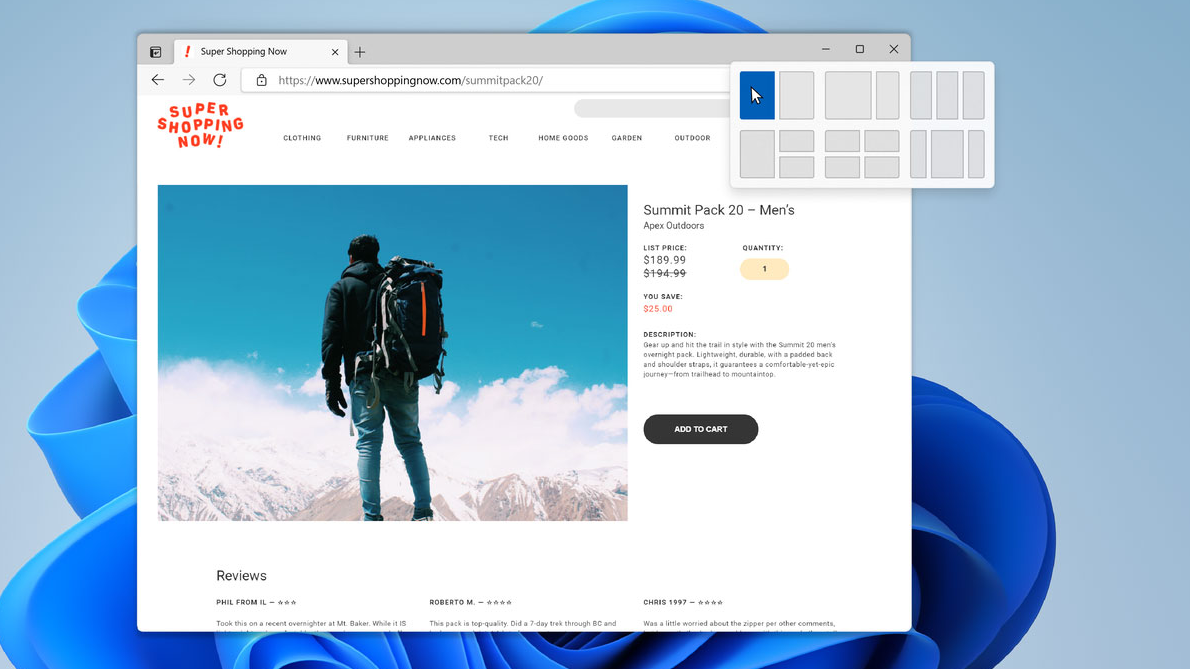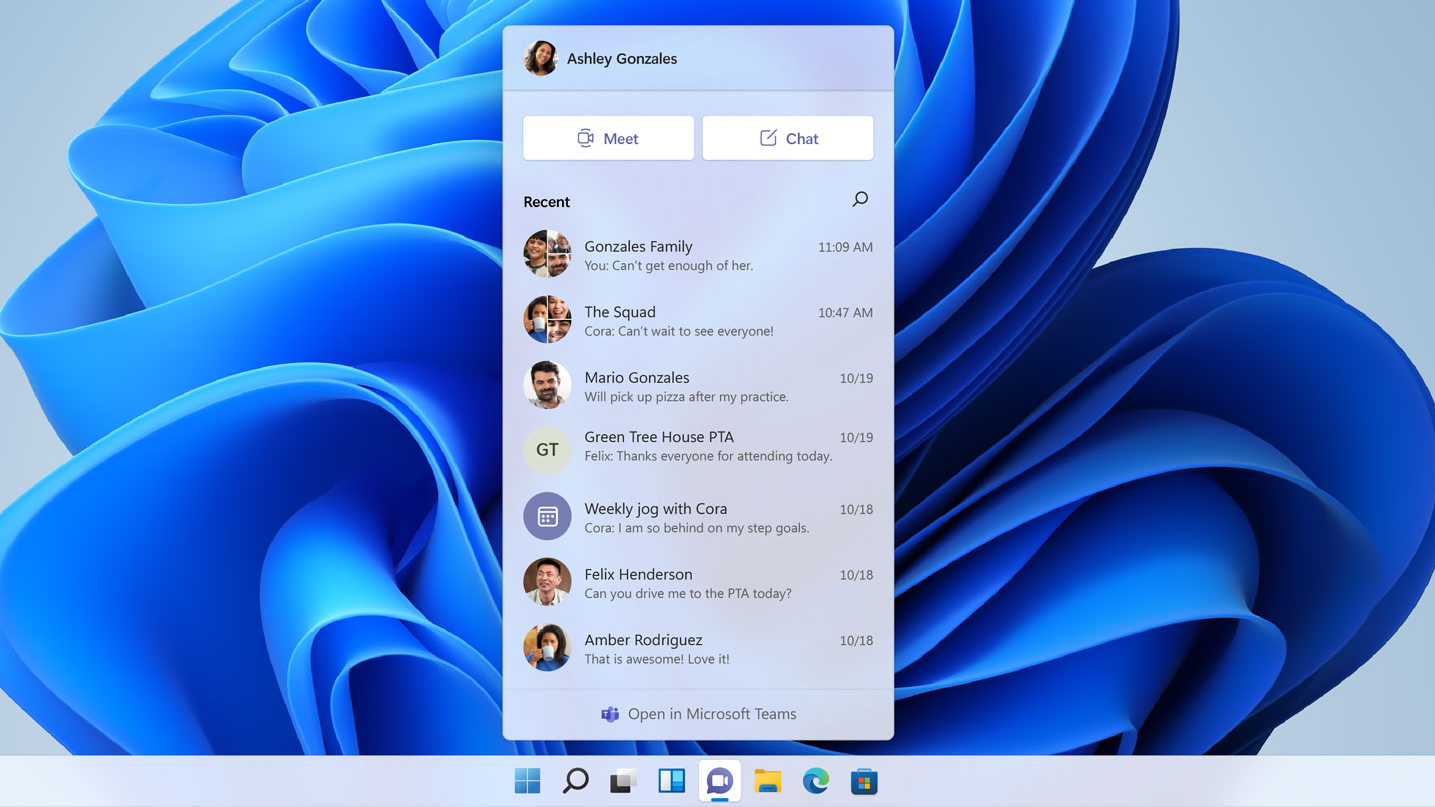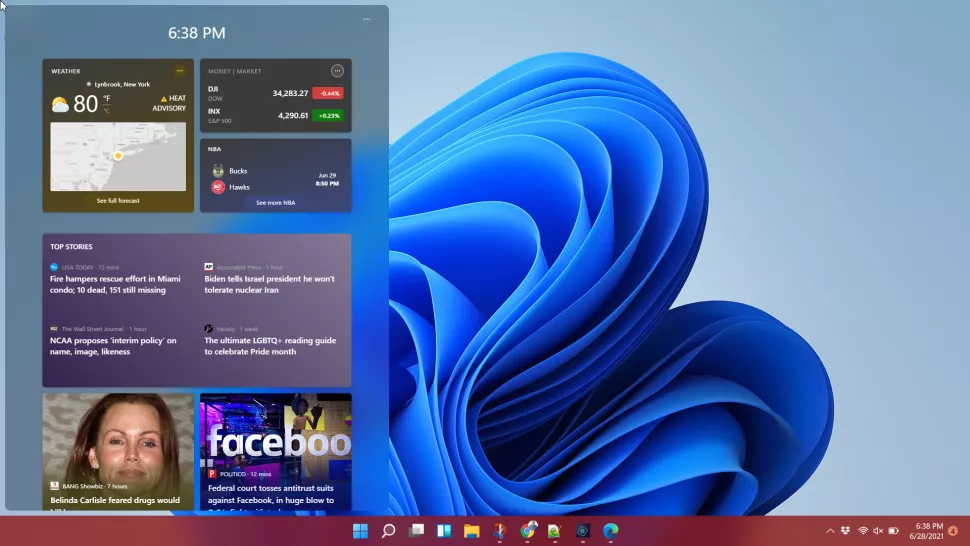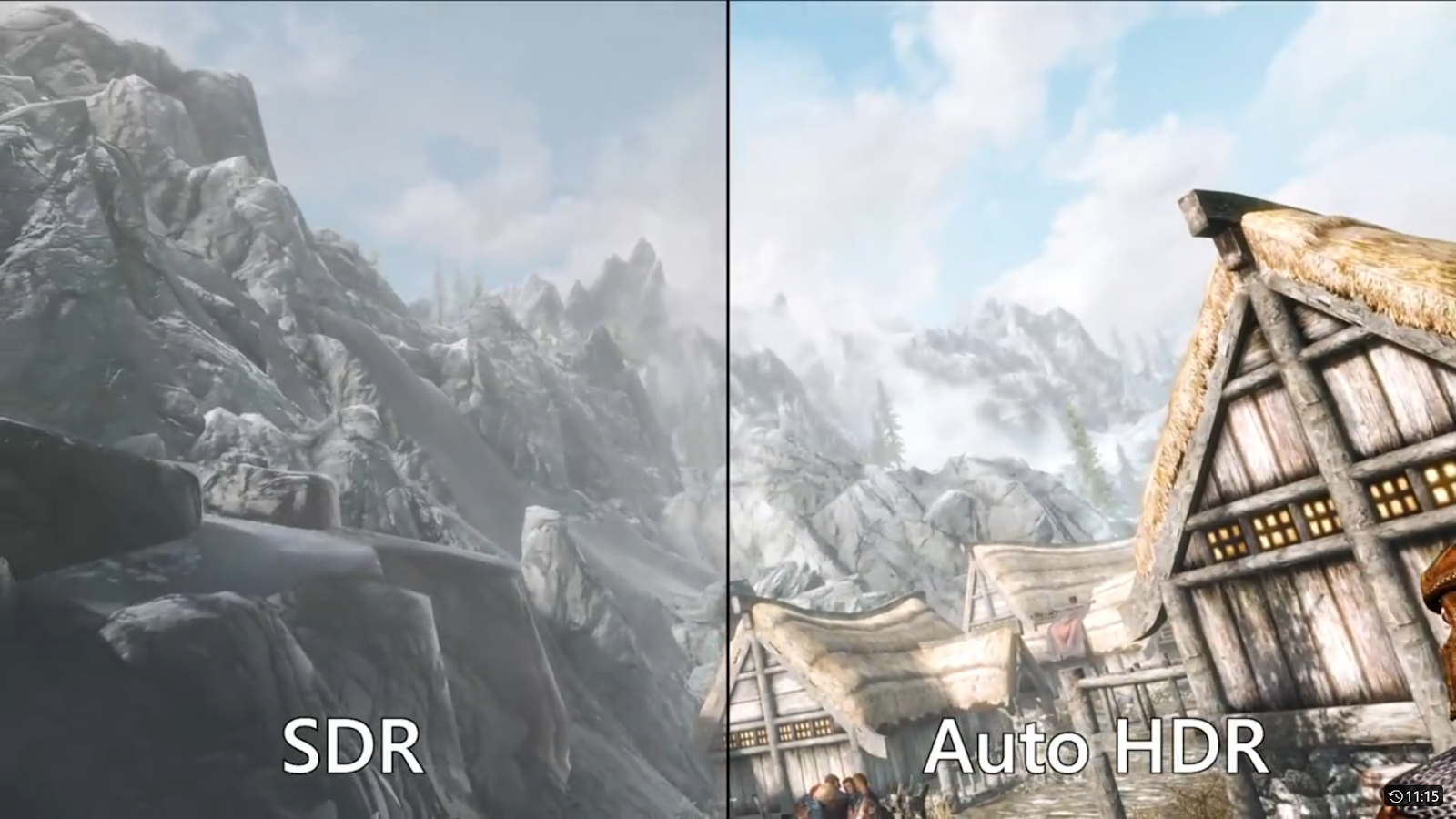Windows 11: Release Date, Requirements, All We Know
Microsoft's next OS has a slew of new features.
Microsoft's next-gen desktop operating system, Windows 11, is already available in beta preview and will be released officially on October 5th. Windows Insiders have been testing out the operating system for a couple of months now so we already know exactly how the UI looks and feels. Here’s everything you need to know about Windows 11 right now.
Release Date for Windows 11: October 5th
At its initial press conference, Microsoft said that Windows 11 would be out by "holiday 2021," which in theory, could have meant any time between October and December. However, just this week, the company announced an official launch date of October 5th.
If you already own a Windows 10 PC and it's eligible for an upgrade, you may not receive your Windows 11 update in October or even in 2021 as the company plans a tiered rollout of updates. Of course, if you install Windows 11 from an ISO file, you can probably force an update.
Insiders Can Preview Windows 11 Now
If you’re signed up as a Windows Insider, you should be able to upgrade an existing copy of Windows 10. Anyone in the Dev or Beta channels is eligible to get the Windows 11 Insider builds, even if their hardware doesn't meet all the system requirements.
To sign up or change your channel in Windows Insider, go to Settings->Update and Security->Windows Insider Program. If you upgrade, you can rollback from Windows 11 to Windows 10 within 10 days.
If you'd like, you can also do a get a Windows 11 ISO file and do a clean install, without a product key or membership in the Insider program. You don't even need a spare PC as you can install Windows 11 on a virtual machine.
Going Hands On With Windows 11
We have had the opportunity to spend several hours testing the new OS and have posted a hands-on and first impressions of Windows 11 article. Our takeaway is that many of the UI elements like the Start Menu look more modern but also appear to take up more room or pack less information into the same space as Windows 10. Some will like the changes, but we didn't love all of them.
Get Tom's Hardware's best news and in-depth reviews, straight to your inbox.
Free Upgrade
Like Windows 10 before it, Windows 11 will be a free upgrade for anyone who has a recent prior version of Windows and the right hardware. The company lists certain minimum requirements (see below) though you can probably get around them if you do a clean install from an ISO file.
Customizing Windows 11
If you're trying Windows 11 out today, there are several things you can do to customize the UI. We've written tutorials that explain:
- How to Make Windows 11 Look Like Windows 10
- How to Change the Start Menu in Windows 11
- How to Resize the Taskbar in Windows 11
- How to Get the Windows 10 File Explorer in Windows 11
- How to Move the Taskbar to the Top in Windows 11
Windows 11 Requirements Could Leave Some Out
According to Microsoft’s blog, the minimum system requirements are:
- CPU: 1-GHz or faster with 2 or more cores on a 64-bit processor.
- 4GB of RAM
- 64GB of storage
- UEFI BIOS with Secure Boot
- TPM 2.0
- 9-inch or larger screen with 720p resolution
- Internet connectivity and an MS account. No offline installs.
- GPU compatible with DirectX 12
These exceed the Windows 10 system requirements in a number of ways. Microsoft lists those as 1-GHz CPU (but not dual core or 64-bit), just 1 or 2GB of RAM, a mere 16 to 20GB of storage space and a GPU that is capable of DirectX 9 with a minimum resolution of 800 x 600.
The TPM 2.0 requirement could shut out a lot of users, particularly those with home-built PCs. Not every motherboard comes with a TPM module on-board, though some motherboards are upgradeable with a TPM module you can buy after the fact. Many systems have TPM on board but it comes disabled so you’ll need to turn it on your BIOS.
It also turns out that Microsoft plans to release non-TPM versions of Windows 11 for countries that don't support or have banned TPM, including Russia and China. The fact that Microsoft can do this really calls into question whether TPM 2.0 needs to be a hard requirement for anyone.
But wait, it gets more complicated, because even though Microsoft's spec list mentions a 1-GHz, 64-bit, 2-core CPU as the minimum, the company also has a list of supported CPUs and most processors that are 7th Gen Intel or 1st Gen AMD Ryzen or below aren't on it (more on that below).
Microsoft has also released an even more detailed list of Windows 11 requirements (PDF download), that mentions some hardware requirements for OEMs who are building Windows 11 PCs.
Most of these are no-brainers like having a power button that actually turns the computer on when pressed. But interestingly, all new non-desktops will be required to have front-facing cameras of at least 720p resolution starting in 2023. Also, all Windows 11 PCs that use touchpads must have Windows Precision Touchpads and all non-desktops are required to have Bluetooth LE connectivity. All computers, even desktops, require some kind of network connectivity, though Wi-Fi is not required.
Even Fairly Recent CPUs May Not Run Windows 11
Microsoft has said that even computers which have TPM 2.0 and secure boot, but are older than an Intel 8th Gen Core or AMD Ryzen 2000 series CPU won't be supported in the final release. The company released AMD and Intel CPU compatibility lists that have a few 7th Gen Intel processors on them but still omit Ryzen 1000 series or anything older.
The good news is that there is a way around some of the requirements. If you use an ISO rather than Windows Update to do your upgrade, you can get way with using an older CPU. However, you will still need at least a dual-core, 64-bit processor, 64GB of storage and TPM 1.2. The OS will also tell you that your device is in a "unsupported state."
New Start Menu
The new Windows Start menu appears by default in the middle of the screen, though you can change a setting to make it appear on the left. Gone are the live tiles, replaced with simple, colorful icons.

According to Microsoft, the menu uses “the cloud” to help you as it shows recommended apps / documents, no matter what device you were working on previously. As an example, Microsoft Partner Director of Windows User Experience Carmen Zlateff showed how a document she was looking at on her phone appeared in the Start menu on her PC.
Windows 11 also has a new Search experience, which now appears in a separate window (no more text search bar). It’s supposed to also search across devices and services, as well as using Bing search for the web.
Black Screen of Death Replaces Blue Screen
According to the Verge, Microsoft plans to change the color of its infamous Blue Screen of Death for the final release of Windows 11. However, right now, the preview build does not necessarily give you a black crash screen, unless you change a setting in the registry.

Dynamic Refresh Rates
Windows 11 supports Dynamic refresh rate (DRR), which allows it to seamlessly switch between low refresh rates (60 Hz) and high ones (120Hz+) in order to balance power usage and user experience. If you have a monitor that is 120 Hz or higher, a graphics card that supports AMD FreeSync or Nvidia G-Sync and apps that support this feature, the screen will go to the lower refresh rate when nothing is happening on screen but as soon as you start to scroll or draw something, the rate will tick up.
Your graphics card will need to also have new WDDM 3.0-compatible drivers. Current apps that support the feature include Microsoft Office, Edge, Adobe Acrobat, Adobe Illustrator, Microsoft Photos and Drawboard PDF.
Snap Layouts and Snap Groups
On Windows 11, hovering over the minimize / maximize button gives you a choice of different snap layouts, based on your screen size. So, for example, if you have three apps open and enough room, you’ll be offered the option to split evenly between all three or have one take up half the screen and the other two take up a quarter each.

If you have to interrupt your workflow by, for example, responding to an incoming email, you’ll be able to restore your snapped layout by clicking on an icon on the taskbar. Icons for these “snap groups” will appear next to app icons so you can easily switch back to a complete layout in one click.

Docking and Undocking: Windows 11 Remembers
If you have a tablet or laptop that you dock to an external monitor and then undock, Windows 11 will automatically minimize the windows that were on the external monitor(s) when you disconnect from them and then automatically restore them to the monitor when you reconnect. This is a huge win for anyone who has to take their laptop into a conference room for a meeting and then back to their desk after it's over.
Virtual Desktops Now Allow Custom Wallpaper
The virtual desktop experience has been improved so now each desktop can have its own wallpaper and distinct look. As in Windows 10, you can also rename virtual desktops so it's easier to separate work tasks from home tasks.

Teams Integrated with Windows
The Teams icon will be on the taskbar and you’ll be able to use it to make calls to anyone else who uses Teams on any device, including Android and iOS devices. You’ll also be able to send and receive SMS messages from the taskbar.
The news feed adapts to you, trying to bring in feeds that you want, based on your preferences. There’s also a feature that lets you give some content creators a tip.

Windows Widgets
A slide-out pane on the left side of the screen shows you “Windows widgets” a set of curated news, weather and stock information. This is a clear evolution of the weather and news bar we see in recent versions of Windows 10.
When we tried Windows 11's window widgets feature in the preview build, we were less-than-impressed. It has a nice looking translucent background, but the mix of widgets reminded us of the home page of MSN or any other web portal.

New Touch Experience
Say goodbye to “tablet mode.” When you go into tablet mode on a 2-in-1, you’ll see slightly more space between icons and larger touch targets, but the interface will remain largely the same. You’ll be able to use the same gestures -- three finger swipe for example -- that you use on a Windows Precision touchpad as well.
The pen experience has been updated to allow haptic feedback as you write. The touch keyboard is all-new and will let you customize its look and feel while also using emojis. Voice typing has also been improved and automatically adds punctuation while taking voice commands such as “delete that” to help you edit.
Auto HDR for Gaming
If your monitor supports HDR but your game doesn’t, Windows 11 will convert the color and lighting. During a demo, Microsoft’s Sarah Bond showed how this feature made Skyrim look much more colorful and lifelike. This feature originated on the Xbox and is now coming to the PC.

DirectStorage Helps Load Times
Another Xbox feature now bound for Windows, DirectStorage allows your game to load content directly from your NVMe SSD into your GPU’s memory, without using a lot of CPU resources. This means faster level load times and less time spent waiting.
Xbox Game Pass Built In
Xbox Game Pass will come built into WIndows 11 so, if you purchase a membership, you’ll have access to hundreds of titles. Xbox Cloud Gaming will also be available so you can even play on systems that have lesser hardware.
New Microsoft Store Policies
The store will support all kinds of apps, including those programming as PWA, UWP or Win32 formats. If you use your own commerce engine, you will not have to pay any revenue share to Microsoft at all. However, if you use Microsoft’s engine, you’ll have an 85/15 split for regular apps or 88/12 for games.
Android Apps Coming to Windows 11 . . . Eventually
In a future update, but not at launch, you will be able to run Android apps directly within Windows and find them in the Microsoft store via Amazon’s own app store. You'll also be able to sideload Android apps, though you won't be able to get them from Google's Play Store.
Windows will use Intel’s Bridge Technology, a run-time post compiler, to allow the Android apps to run natively and be treated like any other Windows app that you can snap, pin-to-start, etc. Panay demonstrated this feature by running TikTok.
Yes, this technology will work on both AMD and Intel CPUs. Intel writes that “Intel Bridge Technology is a runtime post-compiler that enables applications to run natively on x86-based devices, including running those applications on Windows.” More importantly, on a later broadcast, Microsoft Head of Developer Platform Kevin Gallo confirmed that this "Android subsystem for Linux" would run on both brands of processor.

Windows 11 Ready PCs
Get ready for the marketing blitz. Microsoft says that “Windows 11 ready” PCs are coming. Considering that the hardware requirements are so low that pretty much any new PC can meet them, this sounds like more marketing hype than useful information.
We have already received updates from Acer and Dell saying that either all of or the vast majority of their recent offerings are Windows 11 compatible. Suffice it to say that if your PC has less than 4GB of RAM and a sub-1-GHz processor, Windows 10 probably isn’t working very well for you either. However, we don’t know if all of these computers came with TPM 2.0 modules on their motherboards.
Avram Piltch is Managing Editor: Special Projects. When he's not playing with the latest gadgets at work or putting on VR helmets at trade shows, you'll find him rooting his phone, taking apart his PC, or coding plugins. With his technical knowledge and passion for testing, Avram developed many real-world benchmarks, including our laptop battery test.
-
sonofjesse Interesting about TPM 2.0. I dont' think a lot of home builders buy TPM chips and install them.Reply
Also no offline installs and MS accounts required? -
TJ Hooker Reply
It's funny, I always thought my mobo had a TPM because Windows reports that I have one, but thanks to your post I double checked and it doesn't. Turns out what I'm probably using is Intel PTT (platform trust technology), which is a firmware implementation of TPM that appears as the real thing to the OS. AMD has an equivalent fTPM.sonofjesse said:Interesting about TPM 2.0. I dont' think a lot of home builders buy TPM chips and install them.
So I don't think the TPM requirement would be an issue for most people, as their CPUs will provide a FW based TPM even if they lack a discrete module. -
Giroro Its 2021. Everybody and their dog is out there making "content". Windows does not include even a basic video/audio editor, and HEVC decoding is still an optional upcharge.Reply
Yes I know it has the useless "does whatever it wants" editing in the photos app, but that doesn't even come close to the baseline windows XP level of "cut a single long clip down and throw some text on for youtube, maybe with music" -
ThatMouse Still doesn't address the issue of what happens when I try to upgrade my 4 PC's on various Windows 10 installs, with no clear way to see which keys are being used. Looks like I'll be using the same "key" again.Reply -
Awev The TPM is the first of a number of reasons I think I will pass. Next, can I rip out and remove Team and Gamepass? How about Edge? I want to customize my operating system the way I want to use it. How about OneDrive and Contra - are they both still forced on people?Reply
And of course M$ is lying if they say only 2GB of RAM :LOL: - which doesn't matter since I have 16 GB RAM installed. -
Giroro Would it be too much to ask for a hardware monitor capable of telling people when their CPU is overheating? Particularly, without needing admin privileges just to see a basic temperature.Reply -
Awev Micro$oft has released a PC Health Check program to see if your computer is able to upgrade to Windoze 11. I failed - and it failed to tell me why. Since I built the computer myself I am guessing it is because I do not have TPM2.0 dongle installed. I am kind of glad, I don't want to have to unplug my ethernet cable to avoid being connected to M$ to do an upgrade/fresh install. I already use Linux a fair amount, guess I will be using it a lot more.Reply -
USAFRet Reply
There is almost certainly nothing wrong with the current Windows version you're using now (Win 10?).Awev said:Micro$oft has released a PC Health Check program to see if your computer is able to upgrade to Windoze 11. I failed - and it failed to tell me why. Since I built the computer myself I am guessing it is because I do not have TPM2.0 dongle installed. I am kind of glad, I don't want to have to unplug my ethernet cable to avoid being connected to M$ to do an upgrade/fresh install. I already use Linux a fair amount, guess I will be using it a lot more. -
Awev Reply
You mean other than being Windoze? Isn't that a problem to begin with - security, privacy, bloatware, not properly optimized for CPUs and GPUs, and it just being from Micro$oft? I am running Win 10 Pro so I do have a bit more control such as to when updates get installed. I have managed to strip out the stuff I don't need yet Micro$oft tries to integrate into the system, and no I do not mean Candy Crush, I mean things like the new weather and news widget (anyone remember Vista?) and OneDrive.USAFRet said:There is almost certainly nothing wrong with the current Windows version you're using now (Win 10?).
I am sure that when I build my next computer I will have Win 11 installed on it, as I don't plan to build it until the next generation or two of Zen is out, and if M$ gets rid of the requirement for the OS to phone home and for you to have a M$ account. Yet I am happy to stay with Win 10 Pro for the next few years, and whatever version Mint is on (dual boot). -
USAFRet I meant in the context of Win 10 vs Win 11.Reply
(But you knew that....;) )
There seems to be no huge compelling need to change. So don't worry about it.
